What re you going to do when a good friend shows up with an old speaker system and tells you to make something cool out of it?
One of the speakers in all its tiny glory. It really isn’t as big as it looks on the picture!
Okay – first you put it away for some time so you can move. When that’s done you order a bluetooth module from ebay and whip up one of those small amplifier circuits that you designed last year. Lastly, you shove it inside one of those speakers and dance because you now have something that will sound way better than the cellphone you would be listening on before!
It really is that simple. Whoever said that building a small stereo should be hard and cumbersome is wrong!
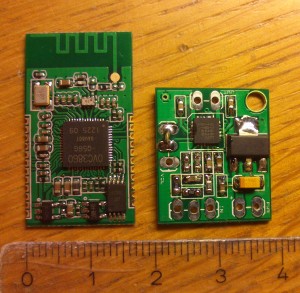 The modules themselves are really small. The right one is of course the amplifier. The left one is an OVC3860 breakout module bought on ebay for about 35DKR (~6$).
The modules themselves are really small. The right one is of course the amplifier. The left one is an OVC3860 breakout module bought on ebay for about 35DKR (~6$).
The pinout can be a be a bit hard to find, which also was the main reason I haven’t finished this project earlier. however, I managed to find a bit of information and as with so many of the other bluetooth audio modules out there it is really simple.
The only parts that I needed to add besides cables was:
1. 100uF capacitor on supply terminals for the bluetooth module
2. 10K potentiometer for volume control on the amplifier side. the bluetooth module has a high-pitched noise when no music is playing and the amp. volume is on 11.
3. power jack
(4. on-off switch – but only because I had one that was suited. Otherwise I would have done without)
The only downside, which is also reported by other users of the module is that when doing a hard-off. the module doesn’t have time to report to the phone that it’s turning off. this means that the bonding between the module an the phone is kept by the phone. to reattach the module, I need to toggle the bluetooth on my phone.
Well, I promised you som schematics of the module – here they are:
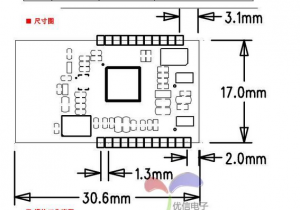 The top one also describes a small speaker/headphone amp, which I don’t think is present on the module. To do soft-reset, connect pin 14 to ground for a second or two. the same to power on again. this approach makes sure that the bonding is done properly.
The top one also describes a small speaker/headphone amp, which I don’t think is present on the module. To do soft-reset, connect pin 14 to ground for a second or two. the same to power on again. this approach makes sure that the bonding is done properly.
The two small modules was glued to a piece of Veroboard and put inside the speaker. The heatsink is on the linear regulator providing 3.3V for both the amplifier and the bluetooth. the bluetooth is pretty power hungry!
There really isn’t anything more to it! power in, music power out!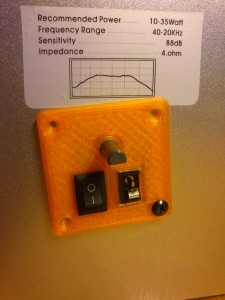 These days nothing is complete without something 3D-printed. So I figured that I could make a cool-looking back panel to hold volume control and power connection. Somehow I managed to screw up 43mm with 45, so the mounting holes are off. I will redo the panel soon. (as if – if it ain’t broken, don’t fix it, right?)
These days nothing is complete without something 3D-printed. So I figured that I could make a cool-looking back panel to hold volume control and power connection. Somehow I managed to screw up 43mm with 45, so the mounting holes are off. I will redo the panel soon. (as if – if it ain’t broken, don’t fix it, right?)


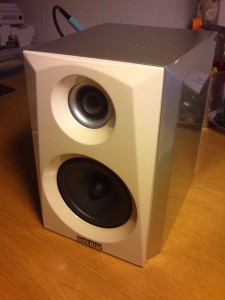
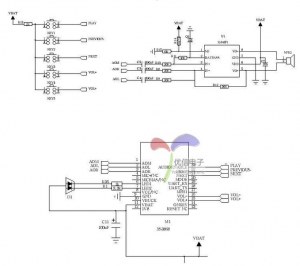
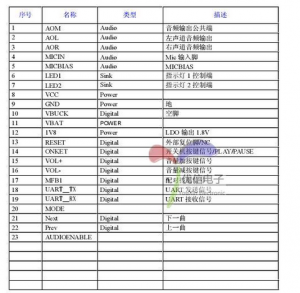

Jeg har tilsluttet en forstærker af samme design(den der er brugt til Roskilde Festival 2013) til et bluetooth modul.
Jeg får også en ‘high pitch’ lyd når der ikke spilles musik – men kun hvis bluetooth modulet drives af spændingsregulatoren på forstærkeren. Det er uanset hvilke værdier af konsensatorer jeg sætter mellem Vin på bluetooth-modulet.
Hvis jeg bruger en anden strømforsyning til bluetooth-modulet, kommer der ikke en højfrekvent lyd.
Spændingen fra spændingsregulatoren synes ikke at være specielt støjfyldt, så jeg har tænkt lidt over om det kan skyldes der ikke er isolation mellem nul(0) og “common ground” på audio-siden?
Eller har du andre idéer til, hvorfor der kun er en hyletone når samme spændingskilde bruges til begge moduler?
Mvh Paw
Hej Paw, (igen) undskyld det sene svar.
Det er fedt at høre at der er nogen der roder med de små forstærkermoduler! Jeg har selv haft problemet med den hyletone, men gjorde ikke noget ved det, fordi det ikke var så tydeligt når man spillede musik. Jeg vil tro at problemet skyldes forstærkerens switching frekvens. Jeg tror også at du har helt ret med hensyn til isolationsproblemet. Men om det kan fikses, ved jeg ikke endnu.
Do you have any Idea hot to get rid of the high pitch noise?
Hey there – Sorry for not getting back sooner!
I have two ideas for the sound:
First thing would be to add an opamp as a buffer. I dont know what the output impedance of the bluetooth module is so it might be as simple as an impedance mismatch.
The other thing could be residue from the internal amplifier. Who knows – maybe it’s a class D and the filters might or might not be there. So some swtiching element of the signal that gets channeled through.
Although it is mysterious that the noise is only present when music is not playing…